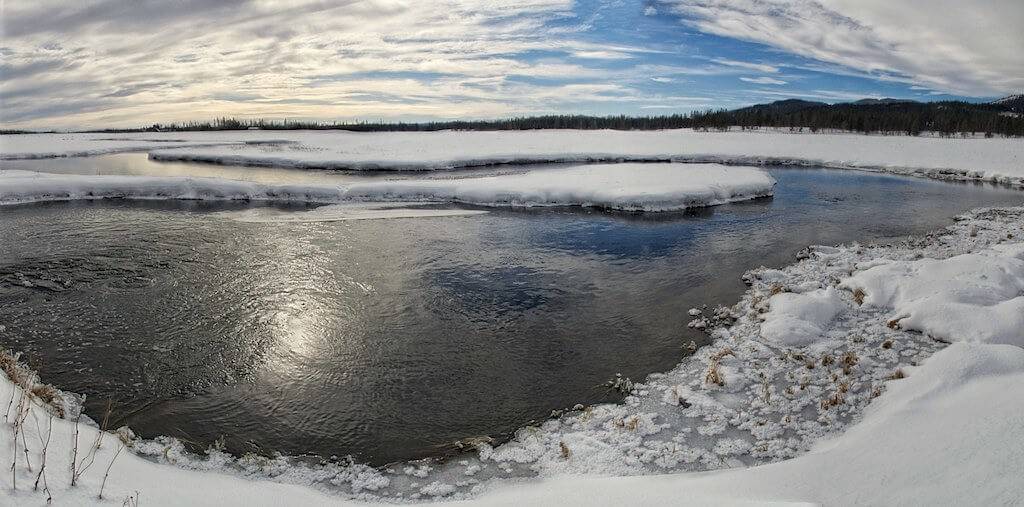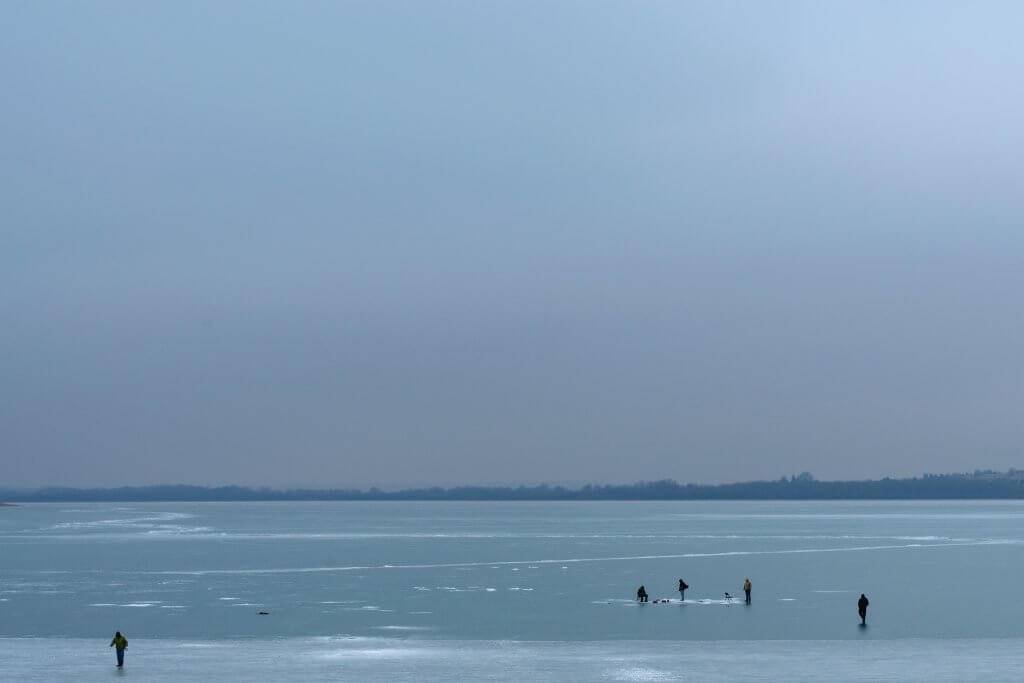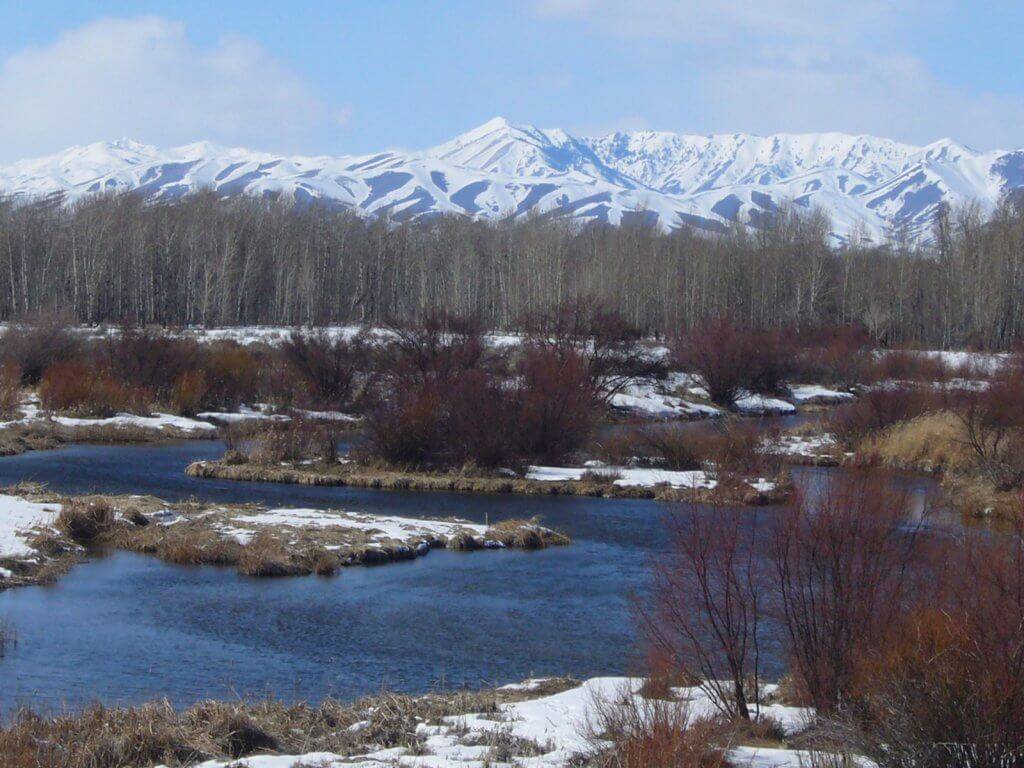Chris Hunt worked in partnership with Visit Idaho to create this Travel Tip.
As I stand up to my knees in the lower Henry’s Fork under cold, gray winter skies, everything is hushed. I can’t hear cars from the nearby road, mostly because there aren’t any. The songbirds are quiet—or they’ve moved on for the season, choosing warmer climates and more forgiving landscapes. Even the river is muted.
Or at least it feels that way.

The Henry’s Fork fishes well through the winter. Photo credit: J.E. Norton, courtesy of Idaho Department of Fish and Game.
Perhaps it’s the three feet of snow lining the banks of one of America’s most storied trout streams that muffles the noises more common in other seasons. Or maybe it’s just all in my head. It’s deathly quiet, still and cold.
I can feel the river’s presence at the base of the Island Park Plateau. I know that it flows nearby—slowed by winter’s grip and lower than it is after it collects all the surrounding snow as meltwater come spring. The three feet of snow along the banks insulates the river, and the canyon walls above me, into something resembling what can only be described as nature’s recording studio. What sounds do penetrate the din are crisp and bright. Snow falls from the branches of dormant willows and thunders like an avalanche. My footsteps squeak in the powder as I walk to the back of the truck. As I lower the tailgate, it sounds as though I’ve dropped a ton of I-beam steel from a skyscraper crane.
High above me, a bald eagle scolds me for invading its fishing spot.
The frost slowly fades from my sunglasses as the frames and lenses cool to the outside temperature—the thermometer in the dash had read a chilly 19° F before I stepped out of the truck. The river comes into focus as I reach for my waders. Eyeing the icy stream, I’m well aware that it might not be the best day to be on the water, but I also know that this river holds secrets in the winter that most anglers aren’t willing to discover.
Wader-ed up, hands cloaked in wool and my body protected by layers of fleece and Gore-Tex, I cast a Prince Nymph under a New Zealand strike indicator and settle into winter’s rhythm.
Now and again, a hunk of ice slowly meanders by. The eagle still soars overhead.
The cast is deliberate. I send the fly line whistling through the air and upstream—20 or so winters of fishing here have taught me that this particular run can be plenty fishy this time of year.
The lime-green line settles on the dark water, and the tuft of wool lands quietly. Below it, the Prince drifts near the river’s rocky bottom. I watch it closely, waiting for any twitch, any dip of the indicator that lets me know a fish is feeding on this chilly day in eastern Idaho.
I strip in line as the indicator moves downstream toward me. A tight line is important when nymphing—when the indicator dips, I’ll need to be ready to set the hook and connect with the very fish which make this river so famous.
But on this cast, nothing.
I lift the rod and let a bit of line out, letting the indicator slip down below me. Sometimes, even during winter, trout will take a nymph as it swings and rides toward the surface, but not this time.
Rod loaded, I cast the line upstream again—this time a little closer to the middle of the river, in water that’s just a bit deeper. The Prince drops into the river, and the wool indicator plops down above it. The current grabs the fly line, pulling the rig downstream much too fast, so I mend the line and save my drift. I notice the eyes of my fly rod now bear a thin coating of ice, which I’ll have to remove on the next cast.
And then, I notice that my wool indicator is gone. Instinctively, I lift the rod. A split second later, the line comes tight and the ice coating my rod explodes from the line guides, disintegrating into crystal powder. A 16-inch rainbow trout rockets from the water 20 feet upstream. Fish on!
Moments later, as I cradle the big, healthy trout and get ready to let it go, the eagle chirps at me from above, almost as if to acknowledge my success on this icy winter day. The trout, now recovered from the fight and perhaps a tad bit wiser, slices its tail through the water and slides back into the Henry’s Fork.
I glance up at the eagle soaring near the canyon rim. The quiet after the splashy battle returns. Snow starts to fall from the January sky, reminding me that winter is a heavy season—a relentless few months where fishing must be a deliberate endeavor. Thinking about it and doing it are two different things at this time of year.
On this day, I’m glad I did it.
Can You Fish in the Winter in Idaho?
With enough layers, winter fly-fishing is completely doable, even during the coldest months. And, of course, with the help of some solid winter gear and some basic equipment, dropping bait and jigs through the ice can result in some serious trophies.
Where to Go Winter Fishing in Idaho
Just because it’s cold doesn’t mean the fish aren’t biting. Throughout Idaho, anglers brave the chill and fish all winter long, whether it’s through the ice or by standing in cold rivers and casting to trout. And Idaho boasts some of the best winter trout fisheries in the country.

Lake Lowell can be a great ice fishing destination. Photo credit: Drew Morris/Idaho Department of Fish and Game.
With enough layers, winter fly-fishing is completely doable, even during the coldest months. And of course, with the help of some solid winter gear and some basic equipment, dropping bait and jigs through the ice can result in some serious trophies.
Here are just a few destinations for winter fishing in Idaho for die-hards who refuse to put the fishing gear to rest once the mercury dips:
Henry’s Fork of the Snake River
The Henry’s Fork of the Snake River, near the eastern Idaho community of Ashton, is an excellent winter fishery. It boasts rainbows, a few big browns and lots of mountain whitefish.
South Fork of the Boise River
The South Fork of the Boise River, about an hour east of Boise, is a great tailwater fishery that features native redbands, mountain whitefish and the occasional hungry bull trout.
Snake River Below American Falls Reservoir
The Snake River below American Falls Reservoir holds some of the largest rainbows in Idaho. This is big water, but shore-bound anglers can reach this section in the winter thanks to generally lower flows.
Payette River of Western Idaho
The Payette River of western Idaho as it flows south of McCall can be a great winter fishery as far downstream as the town of Emmett. Rainbows, browns, smallmouth bass and pikeminnow inhabit this famous river.
Henrys Lake in Island Park
Henrys Lake in Island Park is perhaps the best ice fishing destination in Idaho. Big cutthroats, rainbow-cutthroat hybrids and trophy brook trout make this a popular through-the-ice destination.

Cascade Reservoir
Cascade Reservoir features yellow perch and trout and is very popular among ice fishers.
Silver Creek
Silver Creek, a spring creek near the town of Picabo in central Idaho, is a year-round trout paradise. With near-constant spring flows keeping water temperatures somewhat consistent, this beautiful steppe-country stream can produce trophy trout at any time of the year.
Big Wood River
The Big Wood River, near Ketchum, is a great winter fishery for big rainbows as it flows south toward Magic Reservoir. It closes in the early spring to protect spawning trout, but it is fishable throughout the cold winter months.
Twin Lakes Reservoir
Twin Lakes Reservoir, near the southeast Idaho community of Preston, is a great place to go ice fishing once the lake freezes. Through the ice, anglers can access perch, bass and trout.
Coeur d’Alene River
The Coeur d’Alene River in northern Idaho is a noteworthy winter fishery above the city of Coeur d’Alene featuring rainbow trout and migrating cutthroats.
Bear Lake
Bear Lake, on the border of Utah in southeastern Idaho, can be an enjoyable place to go ice-fishing . Locally the lake is known for its winter run of cisco, a small, schooling whitefish that can be netted through holes cut in the ice. It’s also a great place to catch giant Bear Lake-strain Bonneville cutthroat trout and introduced lake trout.
Lake Lowell
Lake Lowell, southwest of Nampa, is a good winter fishery when it gets cold enough to freeze over. It’s a nice winter fishing spot in Idaho for bass, trout, kokanee salmon, crappie and other panfish.
Boise River
The Boise River through Boise is one of the best urban trout fisheries in the country. It features browns and rainbows, and each year, the state releases big steelhead into the river as part of the mitigation for the construction of dams on the Lower Snake River.
Embark on an angling adventure and discover world-renowned fishing spots in Idaho.
Feature image credited Cyndi Coulter/Idaho Department of Fish and Game.
Chris Hunt is the national digital director for Trout Unlimited, where he blogs about fly-fishing almost daily. He’s also written four books on fly-fishing, and his work has appeared in dozens of publications—from the New York Times to the FlyFish Journal and TROUT Magazine. He lives in Idaho Falls.
Updated on October 21, 2022
Published on January 12, 2021



